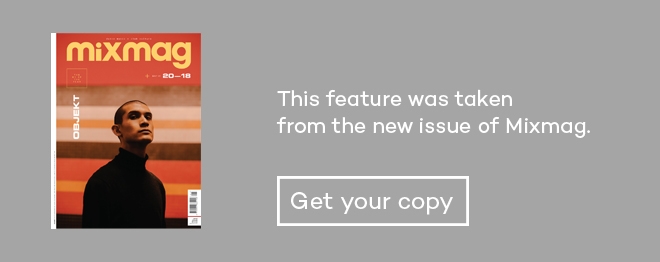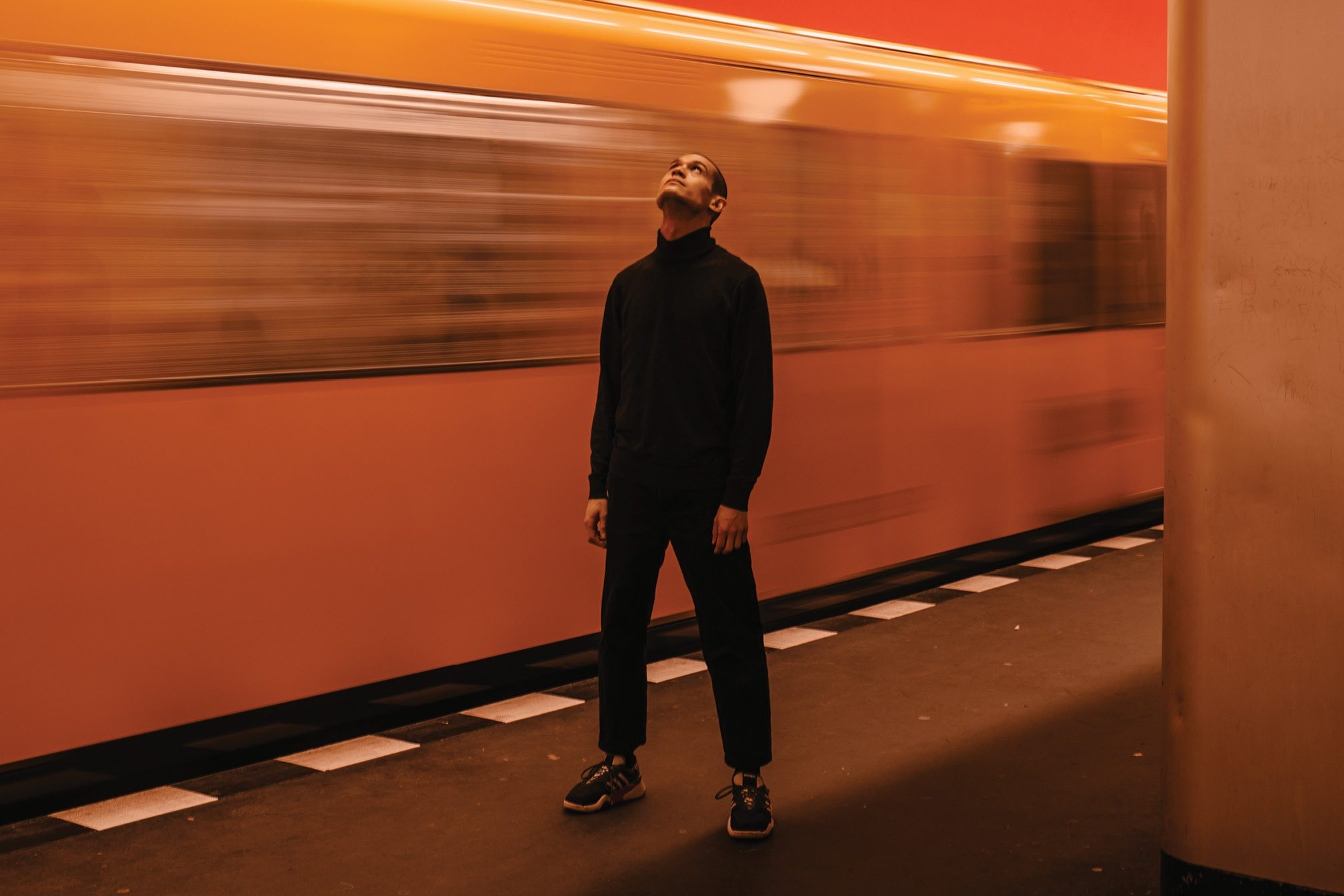 Cover stars
Cover stars
Relentlessly Creative: Objekt is the DJ Of The Year
Our DJ of the year is the incredble Objekt
It’s a Thursday afternoon in Berlin’s multikulti Kreuzberg district, and we’re waiting for Objekt, aka TJ Hertz, to emerge from his apartment block. A couple of young mums with coffees and prams stroll past, closely followed by two middle-aged African men conversing passionately in fluent German. A block or so away, a group of homeless-looking guys sit on the floor, passing a bottle of beer between them. Then suddenly Hertz is there, smaller and slighter than expected, his sharp, high cheekbones lending him more than a passing resemblance to a young John Malkovich.
Hertz has lived in the German capital for around a decade, during which time he’s made the transition from enthusiastic amateur DJ and producer to Mixmag cover star thanks to a slew of cutting-edge, shape-shifting productions – ‘CLK Recovery’, ‘Ganzfeld’, ‘Theme From Q’ – that have subtly redefined what club music can be, while maintaining its inherently hedonistic vibe; two meticulously sculpted, cinematic long players; and landmark DJ sets at festivals like Freerotation and Dekmantel famed for their ability to surprise and slay dancefloors in equal measure. This year he’s been one of the most sought-after bookings on the planet, touring Asia and Australia in the early months, playing a string of North American parties in the spring, and filling the rest of the calendar with stops at just about every celebrated club and festival Europe has to offer.
His popularity is indicative of a DJ who knows how to thrill a dancefloor. But more so than any other DJ in the world right now, he’s pioneering innovations in the craft. In order to bridge wide BPM gaps he’s experimented with a polyrhythmic mixing style, allowing him to jump from 4/4 tracks at 120 BPM to 160 BPM triplet patterns, or from halftime d’n’b to functional techno tempos with unfaltering precision. One of his USB folders, titled ‘floaty rollers’, is comprised of driving club tunes that lack a kick-drum, which he deploys to move a club without relying on a traditional untz untz pulse. And these methods are starting to catch on among his peers. But among all the mathematical mixes and carefully compiled playlists, what also helps Objekt stand out from the crowd is that he never loses sight the main goal of clubbing: having fun.
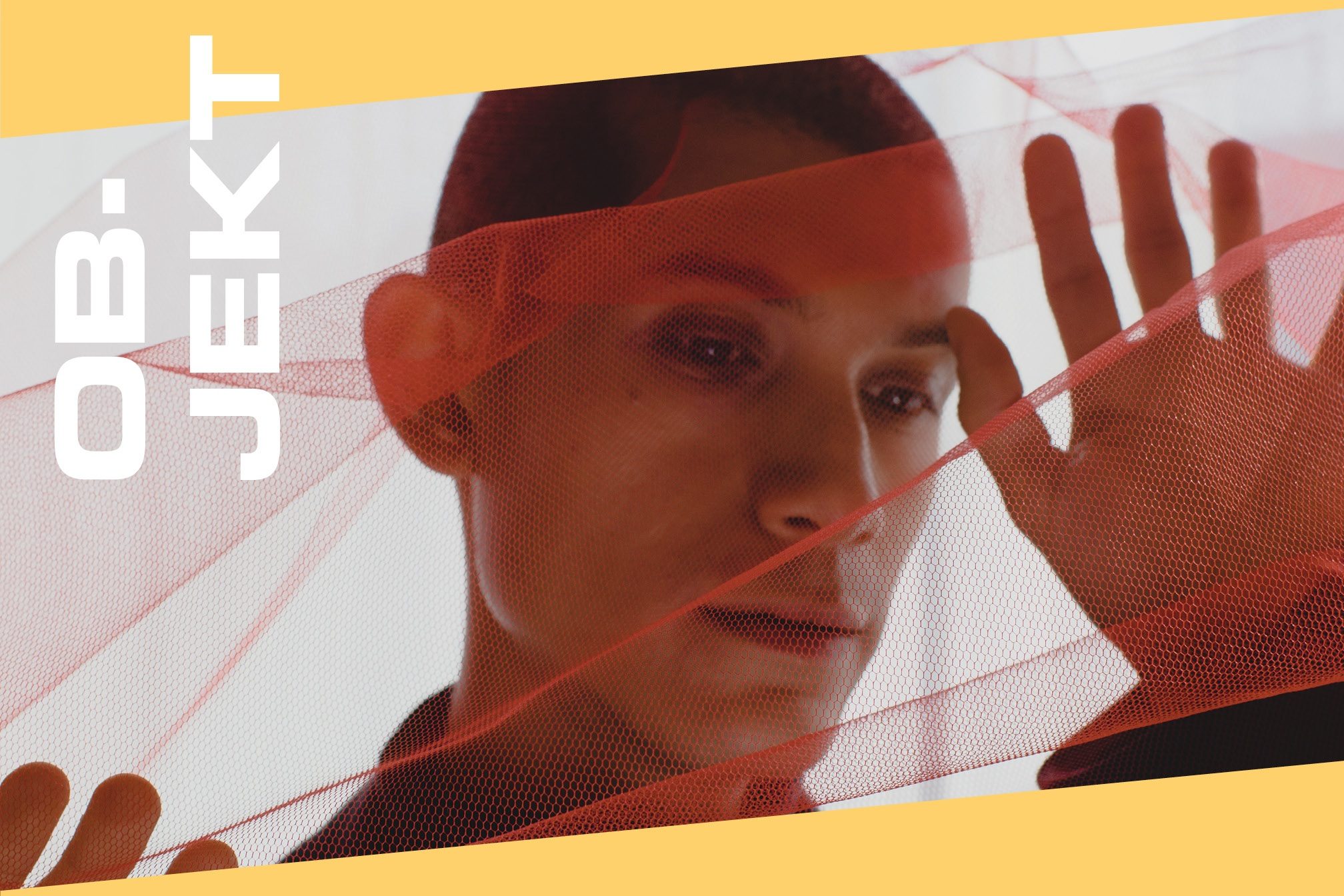
Back-to-back sets with Call Super have seen the pair unashamedly pulling out anthems like ‘Born Slippy’ and ‘Freed From Desire’, and in August he stirred up controversy at Dekmantel by playing SOPHIE’s dance-pop banger ‘Immaterial’ in the techno-centric UFO tent, causing some of the over-serious heads in attendance to accuse him of playing “bait EDM”. After seeing the reaction he quipped on Twitter that he was looking forward to dropping the track “approximately every 20 minutes” at Dekmantel’s sister festival, Selectors. Experimental but fun, meticulous but fearless, his DJing chops are unparalleled.
Hertz clocked up some invaluable experience working as a DSP developer at Native Instruments, a job he only left last year. His former offices, in fact, are right across the street, inside the Höfe am Osthafen business complex; we wander across and pass through the courtyard to admire the views across the river Spree. To our left lies the famous turreted Oberbaumbrücke, part of a former city wall and an official GDR checkpoint when the city was divided in two. On the other side of the river, in what was once East Berlin, lie a string of venues known collectively as the Media Spree.
Music, especially the electronic kind, runs deep in this city – which is, of course, what drew Hertz here in the first place. “I first came here around 2007 as a tourist and to explore the clubs a bit,” he says as we look out over the river. “I was around twenty, and had a lot of fun.” Born in Tokyo to a British-American father and Filipino mother (he has three passports: Filipino, British and American), he moved to Brussels at the age of five, hit Solihull in the English midlands when he was 11, then went to Oxford University to study information and electronic engineering.
“I was very much into techno by that point,’ he says; “the kind of stuff that was on the mnml ssgs blog and labels like Ostgut. By that point I’d been DJing for a couple of years, mostly in Oxford’s Love Bar, The Cellar and the Bullingdon Arms, but was struck by the creative spirit and sense of possibility [in Berlin]. I had been thinking about moving to London, but I came here instead and spent the first year or two just walking around, taking in the potential of all the empty spaces.”
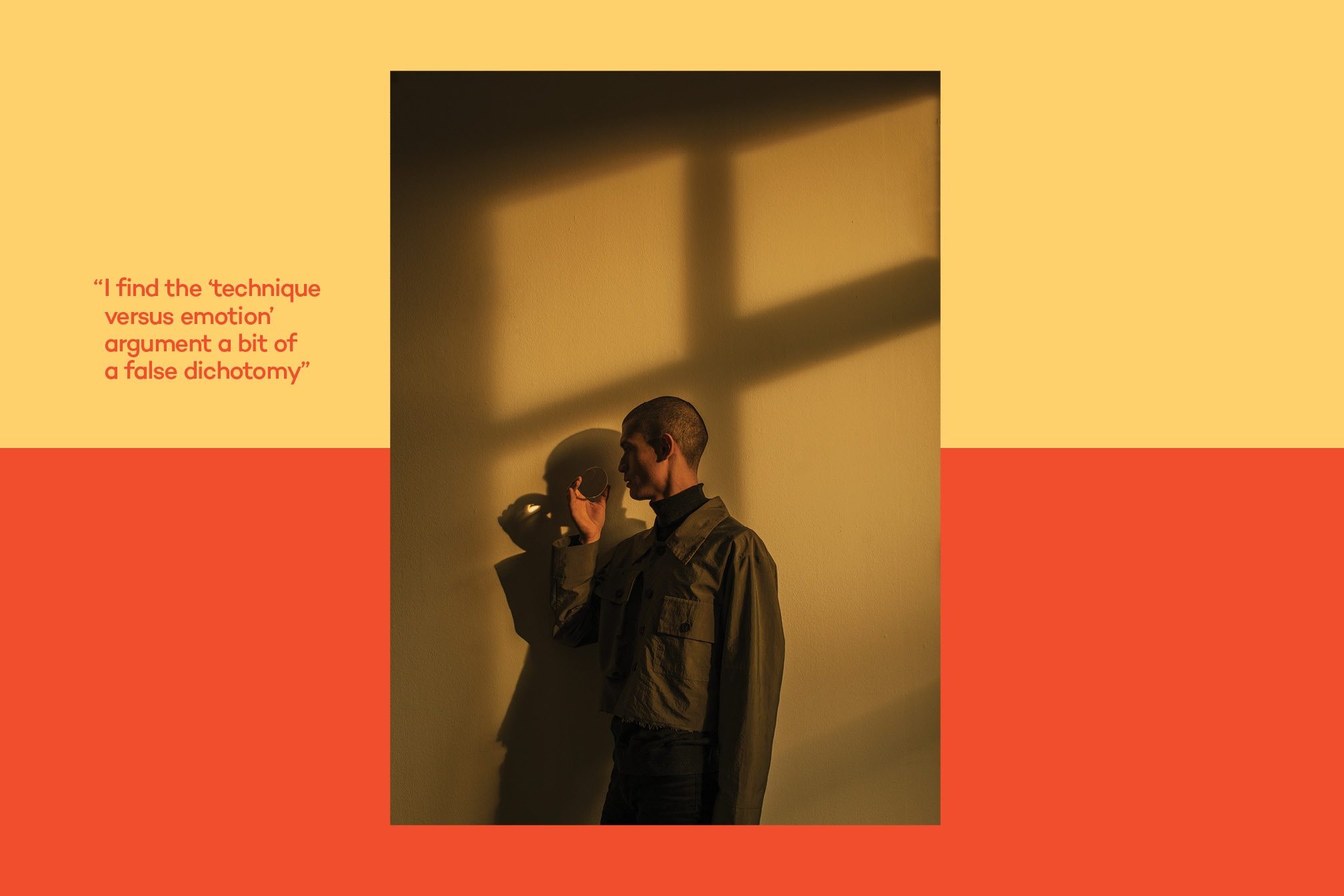
His connection to music came early; his mother was a composer and his father played plenty of music around the house: “a lot of jazz and jazz fusion, virtuosic session musician bands like Al Jarreau and Dave Grusin, a bit of Motown and funk and soul”. He took piano lessons between the ages of five and 12, then got hooked on drums while visiting a family friend. His parents bought him a kit, and he saved up to buy himself guitar and bass, kicking off a teenage band career, which he describes as “a lot of fun, albeit with some regrettable outfits; there was a lot of eyeliner at one point”. By the time he got to university he was signed up to play in more bands than he could manage, and was spending so much time in rehearsals and dragging his kit around that it wasn’t fun anymore and he decided to take a break.
It was during this pause that he started to join his friends at some local clubs, soaking up the trashy charms of bloghouse before moving on to techno. “I couldn’t just watch from the sidelines,” he says. “I had to be involved and find out how it all worked. So I started to DJ and learned how to make rudimentary music on a computer. I quickly realized that as a DJ you don’t face anywhere near the same hardships as a band member. It was a whole new form of music, and also a whole new mode of appreciation. I was attracted to the functionality – the way tracks were made purely to make people dance – and also how you could see the visceral response of people who were actually there to enjoy themselves, as opposed to people who’d been dragged along to their friend’s band’s gig”
Drawing on his limited technological experiences, which mainly consisted of using his mum’s Cubase and Atari ST setup to record rudimentary covers of Tears For Fears songs (“I was around ten at the time and completely unaware there were people in London making jungle on it”) Hertz gradually taught himself how to work with multi-channel audio, sketching out tracks on Reason and, eventually, Ableton. By the time he joined Native Instruments in 2010 he was an Ableton power user, but his role as DSP developer threw up entirely new opportunities to delve into sound – something he says is integral to his production and DJ work today.
“I studied information and electronic engineering at uni, but this was a really different specialisation. I understood the maths, but hadn’t gone into audio applications much at all – so at NI they basically trained me to make synths, audio algorithms, back-end audio stuff. I worked on various products like Maschine, Kontakt and Traktor, and it all fed the methodical part of my personality. It helped me apply similar techniques to my music-making, made me more rigorous with things like structure and workflow, and made me think about sound more visually. I spent a lot of time at NI looking at oscilloscopes and graphs, figuring out the relationship between time and frequency domain, and thinking about how signals change through different FX. It gave me a clearer idea of what each building block is doing and how audio actually works, so that now, when I want to achieve something sound-wise I have a more informed approach of how to do it, rather than clutching at straws. But I think that aspect of my personality would have shone through regardless. It just might have taken longer and brought me to a different place.”
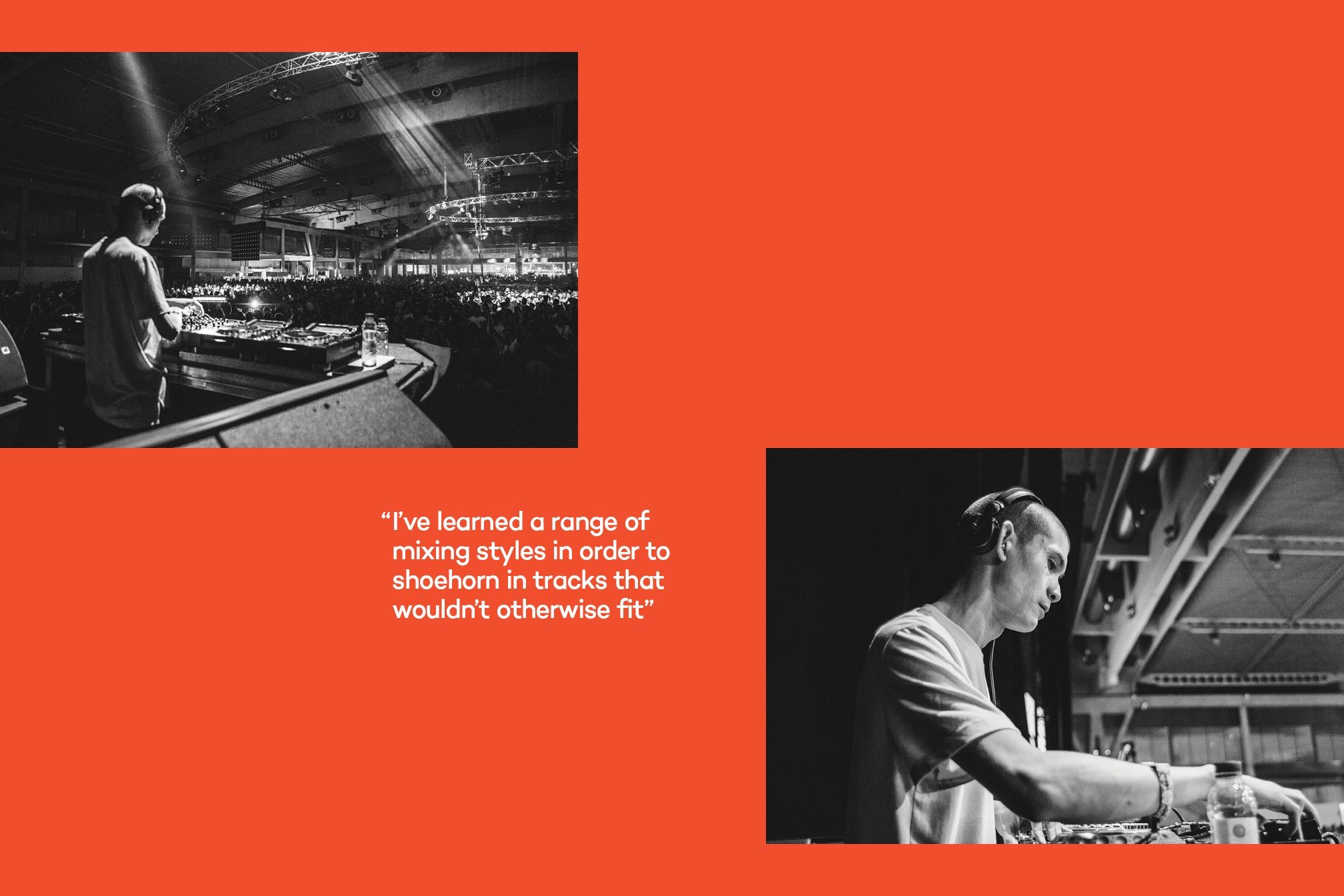
Hertz only left NI in 2017, though he admits he could have done so sooner. His name and reputation, after all, had been building steadily since 2011, thanks to a pioneering slew of productions, namely his Objekt #1-#4 double-siders on labels like Hessle Audio, Leisure System, Power Vacuum, and his own imprint, each one playfully and skilfully mining the rhythmic and melodic zones between dubstep, techno, electro and IDM.
Early tracks like the wobblesome ‘Cactus’, big-room techno behemoth ‘CLK Recovery’ (both 2011), and the electro-fuelled ‘Fishbone’ (2013) adumbrated his restless, shape-shifting aesthetic, which was fully confirmed on his wide-screen debut Flatland (2014), and has continued in recent years with more killer cuts: 2014’s ‘Ganzfeld’, a titular nod to the visual phenomenon of perceptual deprivation known as the ‘Ganzfeld’ effect; the ravey ‘Theme From Q ‘(2017), a nod to one of his favourite Berlin clubs (Basement Q, now closed); and his latest album, ‘Cocoon Crush’ (out in November 2018) on PAN. If anything, the sound design aspect is more prominent than ever on his new album, which often forgoes the propulsive, dancefloor dimensions of ‘Flatland’ in favour of a slowly unfurling cinematic experience, generously punctuated and layered throughout with rich sonic detail ranging from sudden and abrasive clangs and bass shudders to sibilant hisses, heavily processed, sometimes minatory vocals, and ghostly synth melodies. The entire journey, as always with Objekt’s music, feels meticulously, almost fiercely, arranged and joyfully lustrous.
The first album, he explains as we tuck into some cake in a café, consisted of tracks and sketches “glued together via processing techniques”, whereas the new one is both much more personal (“nothing I’d want to expand upon here, but I wrote it in a period when some of my relationships were pretty complicated”), and purpose-built from scratch. There are some sonic overlaps: ‘Nervous Silk’ features some recycled material from ‘Needle And Thread’, both of which reference ‘One Stitch Follows Another’ and ‘The Stitch Up’; ‘Silica’ borrows some drums from ‘Ganzfeld’; there are two versions of ‘Lost And Found’. But overall it sounds more crystalline, and certainly more introverted.
“I pretty much used the same studio equipment for both of them, with the important exception of the REON Driftbox,” he reveals. “It’s a tabletop synth I discovered that steered me towards the ‘cleaner’ aesthetic of the new album. I used it for the bassline in ‘Secret Snake’, and for a lot of high frequency ‘pin-prick’ noises and purer sounding glitches. There are also more natural sound sources in the new one, things like broken glass, sand and gravel, which contrasts with the crunchier, more digital sounds on the first album.”

Although he cheerfully admits to “micromanaging the shit out of everything” (his music for DJing is organised with the same ruthless efficiency, usually in separate crates in Rekordbox according to categories like tempo and mood, and sub-rated for levels of hardness and other aesthetic factors) it’s a mistake to write Objekt off as some kind ofrobot-minded nerd. Beyond the technical innovation and the tricky time signatures it’s the human, playful element to his music, and his mixing, that gives it its power.
“People often talk about the technical aspects of my music, but I find the ‘technique versus emotion’ argument a bit of a false dichotomy. Although my approach is intrinsically technological, I’m excited about tools that allow me to do crazy things without thinking too much: tools that are the digital equivalent of throwing paint at a canvas and then sculpting the resulting splashes into more refined figures. You can use analytical means to evoke different moods without it being sterile or meaningless, or fully calculated. I feel that my new album is very emotional, even if it is heavily thought-through. In the end, I like playing with ambivalence and contradictions. I like that people can feel the tension between discomfort and maybe soothing qualities, or detect the anxiety or euphoria that’s gone into it. The details are there as a means to draw the listener in, but from a mood perspective it’s more about the overall piece than those incidentals. That’s where the focus is for me. I always want my music to make sense from start to finish and to sound natural – an organic entity that has a life of its own.”
His recorded sets are testament to his eclectic vision, as are released mixes for the likes of Tresor (‘Kern Vol 3’), a perfectly sculpted masterclass that joins together ambient drones by Call Super as Ondo Fudd and Bee Mask with dark electro from Mono Junk and Heckmann’s immense ‘Chiswick Days’. “As a huge perfectionist I take forever to get a recorded mix ‘right’ enough to be happy to release it, so I rarely agree to do podcasts or online mixes,” he says. “The mixes of mine that are out there are either recorded club sets which went exceptionally well, particularly if I have especially fond memories of the party itself – which was certainly the case at all the Freerotations where my set was recorded – or studio mixes I’ve slaved over for weeks.
The Tresor mix is a particularly extreme example as it’s the only commercially released mix CD that I’ve done so I put in a huge number of hours sequencing, recording and editing it. I wanted to showcase as broad a repertoire as I could in less than 80 minutes, which is quite hard when you’re growing increasingly comfortable playing at most tempos between 80 and 170 BPM. But I’m super happy with the result. I’m also really happy with the mix I just did for RA – I’ve been meaning to do a propulsive, danceable mix without any kick drums for quite a while now and I’m glad I finally got around to it.”
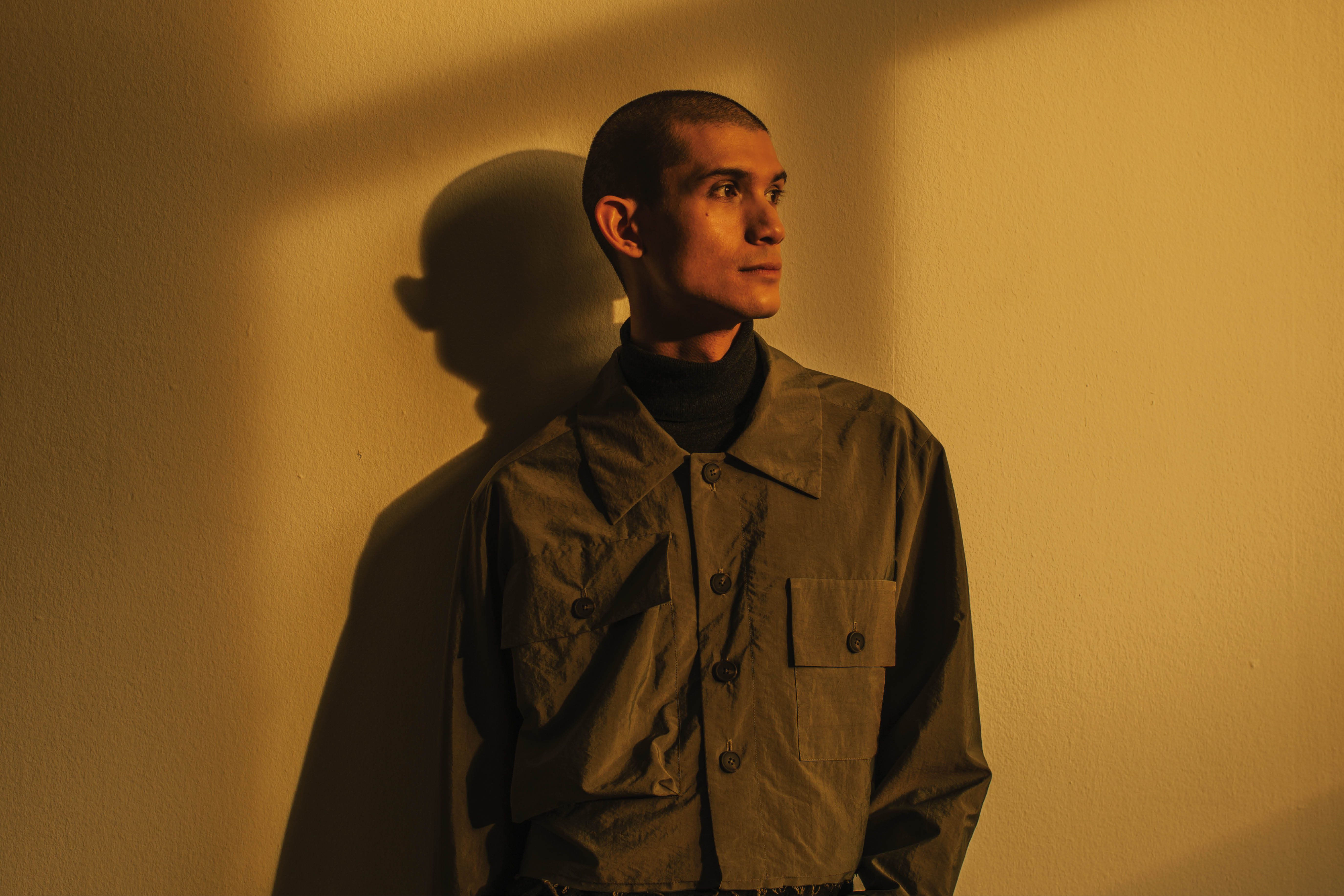
At tonight’s PAN label showcase event at Berlin’s Berghain, we get a masterclass in what makes Objekt such a great DJ. With the main room’s system seemingly pushed to its limit, and the air thick with sweat, smoke and layered sonics, artists like Eartheater and Puce Mary perform live sets that combine serene vocal beauty with punishing noise and ethereal textures punishing bass. Around 5am, Objekt takes over from Amnesia Scanner and proceeds to merge together tracks by fellow envelope-pushers like Stanislav Tolkachev, SND, Evol and Jlin – many of them featuring no kick drums – to shake the room anew.
“I’ve played that annual PAN night at Berghain for four years now,” he says. ”It attracts a much more musically adventurous crowd than your typical Berghain night. I usually try and bring something different each time as I feel it’s a waste to play a standard club set to an audience who would stick with you through much more experimental terrain. I guess my mixing style is pretty dynamic. I’ll do a lot of cuts with the crossfader and some ‘performative’ rhythmic EQing to bring in individual drums or sounds; also some turntable and CDJ trickery here and there. Quite a lot of mixing on three decks, too. I like to think that over the years I’ve actually learned a range of different mixing styles to suit the different genres of music that I play, but it’s also in order to be able to shoehorn in tracks that wouldn’t otherwise fit together.”
The tensions in Objekt’s production and DJing work – namely, his penchant for ignoring the more obvious and generic aspects of dance music culture, especially its tendency to pander to lowest-common-denominator levels of enjoyment, while managing to steadily garner more recognition – would seem to be both a challenge and an opportunity. It’s also an indication that audiences in 2018 seem to be more open than ever.
“Sometimes there is a compromise to make,” he agrees, “but often not. I think that the climate is changing and idiosyncratic music can be picked up by a broader audience than one might think. ‘Needle And Thread’, for example, was picked up by everyone from Ricardo Villalobos to Laidback Luke, whereas ‘Theme From Q’, the B-side, was Mixmag’s track of the year and Ibiza Voice’s top tune of 2017. I was a bit bewildered to find out how far it had gone, but of course it was a nice surprise.”
In terms of 2019, more exciting challenges are afoot. Although he won’t be drawn on the details, fans can begin looking forward to a live set built for festivals rather than clubs, as well as “some degree of production... so it’s not just me showing up with a laptop and playing some club bangers.” For a creative force as restless as TJ Hertz, there are always more worlds to conquer.

